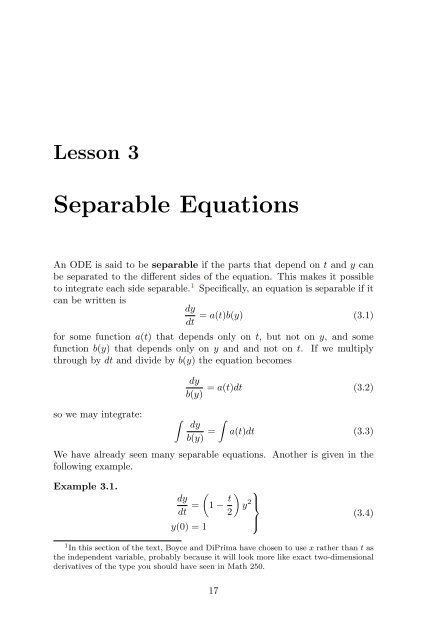Lecture Notes in Differential Equations - Bruce E. Shapiro
Lecture Notes in Differential Equations - Bruce E. Shapiro Lecture Notes in Differential Equations - Bruce E. Shapiro
16 LESSON 2. A GEOMETRIC VIEW Figure 2.4: Direction fields with arrows. See text for details. 3 2 1 0 1 2 3 3 2 1 0 1 2 3 3 2 1 0 1 2 3 3 2 1 0 1 2 3 Figure 2.5: Direction fields with short lines (left) and one parameter family of solutions (right) for (2.11). 3 2 1 0 1 2 3 3 2 1 0 1 2 3 3 2 1 0 1 2 3 3 2 1 0 1 2 3
Lesson 3 Separable Equations An ODE is said to be separable if the parts that depend on t and y can be separated to the different sides of the equation. This makes it possible to integrate each side separable. 1 Specifically, an equation is separable if it can be written is dy = a(t)b(y) (3.1) dt for some function a(t) that depends only on t, but not on y, and some function b(y) that depends only on y and and not on t. If we multiply through by dt and divide by b(y) the equation becomes so we may integrate: ∫ dy b(y) = ∫ dy = a(t)dt (3.2) b(y) a(t)dt (3.3) We have already seen many separable equations. Another is given in the following example. Example 3.1. dy (1 dt = − t ) 2 y(0) = 1 y 2 ⎫ ⎪⎬ ⎪⎭ (3.4) 1 In this section of the text, Boyce and DiPrima have chosen to use x rather than t as the independent variable, probably because it will look more like exact two-dimensional derivatives of the type you should have seen in Math 250. 17
- Page 1 and 2: Lecture Notes in Differential Equat
- Page 3 and 4: Contents Front Cover . . . . . . .
- Page 5 and 6: CONTENTS v Dedicated to the hundred
- Page 7 and 8: Preface These lecture notes on diff
- Page 9 and 10: Lesson 1 Basic Concepts A different
- Page 11 and 12: 3 Definition 1.2 (Solution, ODE). A
- Page 13 and 14: 5 1.22 is restricted to being a pos
- Page 15 and 16: 7 Figure 1.1 illustrates what this
- Page 17 and 18: 9 We will study linear equations in
- Page 19 and 20: Lesson 2 A Geometric View One way t
- Page 21 and 22: 13 We can extend this geometric int
- Page 23: 15 that since the slope of the solu
- Page 27 and 28: 19 Since it is not possible to solv
- Page 29 and 30: 21 where M(t) = −a(t) and N(y) =
- Page 31 and 32: 23 Example 3.10. Find a general sol
- Page 33 and 34: Lesson 4 Linear Equations Recall th
- Page 35 and 36: 27 So far any function µ will work
- Page 37 and 38: 29 Example 4.1. Solve the different
- Page 39 and 40: 31 Since p(t) = 1 (the coefficient
- Page 41 and 42: 33 Multiplying equation 4.68 by µ
- Page 43 and 44: 35 Substituting y = t = 0 in this i
- Page 45 and 46: 37 ∫ t t 0 Evaluating the integra
- Page 47 and 48: Lesson 5 Bernoulli Equations The Be
- Page 49 and 50: 41 This is a Bernoulli equation wit
- Page 51 and 52: Lesson 6 Exponential Relaxation One
- Page 53 and 54: 45 Exponential Runaway First we con
- Page 55 and 56: 47 Figure 6.2: Illustration of the
- Page 57 and 58: 49 This is identical to with Theref
- Page 59 and 60: 51 this becomes a first-order ODE i
- Page 61 and 62: Lesson 7 Autonomous Differential Eq
- Page 63 and 64: 55 Figure 7.1: A plot of the right-
- Page 65 and 66: 57 Figure 7.2: Solutions of the log
- Page 67 and 68: 59 Figure 7.4: Solutions of the thr
- Page 69 and 70: Lesson 8 Homogeneous Equations Defi
- Page 71 and 72: 63 where z = y/t, the differential
- Page 73 and 74: Lesson 9 Exact Equations We can re-
Lesson 3<br />
Separable <strong>Equations</strong><br />
An ODE is said to be separable if the parts that depend on t and y can<br />
be separated to the different sides of the equation. This makes it possible<br />
to <strong>in</strong>tegrate each side separable. 1 Specifically, an equation is separable if it<br />
can be written is<br />
dy<br />
= a(t)b(y) (3.1)<br />
dt<br />
for some function a(t) that depends only on t, but not on y, and some<br />
function b(y) that depends only on y and and not on t. If we multiply<br />
through by dt and divide by b(y) the equation becomes<br />
so we may <strong>in</strong>tegrate: ∫ dy<br />
b(y) = ∫<br />
dy<br />
= a(t)dt (3.2)<br />
b(y)<br />
a(t)dt (3.3)<br />
We have already seen many separable equations. Another is given <strong>in</strong> the<br />
follow<strong>in</strong>g example.<br />
Example 3.1.<br />
dy<br />
(1<br />
dt = − t )<br />
2<br />
y(0) = 1<br />
y 2<br />
⎫<br />
⎪⎬<br />
⎪⎭<br />
(3.4)<br />
1 In this section of the text, Boyce and DiPrima have chosen to use x rather than t as<br />
the <strong>in</strong>dependent variable, probably because it will look more like exact two-dimensional<br />
derivatives of the type you should have seen <strong>in</strong> Math 250.<br />
17



